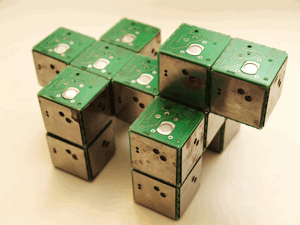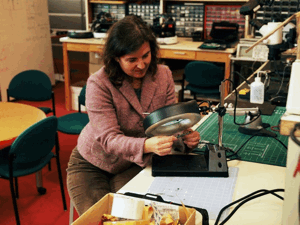Self-reconfiguring Robots
Air Date: Week of July 16, 2010

Smart modular robots are designed to change their shape and behavior. (Photo: Distributed Robotics Lab/CSAIL Center for Robotics/MIT)
Imagine a robot made of small cubes that can join together and change their shape and behavior without human input. A group of MIT researchers have designed these Lego-sized cubes that are programmed to connect and communicate with each other. As Glen Zorpette reports for the IEEE Spectrum Magazine and National Science Foundation series, “Robots for Real,” self-configuring smart robots could have an impact on everyday life.
Transcript
YOUNG: Most machines are designed to handle one particular task, say a lawnmower, or a vacuum cleaner. But robots are “programmable” machines that can change behavior. And researchers are now developing robots that can change a lot more: their shape, their software and their hardware. Our story comes from the series: "Engineers of the New Millennium," from IEEE Spectrum Magazine and the National Science Foundation. Glenn Zorpette takes us to the MIT Lab working on, what you might call… the transformers.
ZORPETTE: Robotics Engineer Daniela Rus sees a future in which robots not only do what we want, they become what we want.
RUS: So that anybody can make whatever robot they need on demand, much like a child might make a toy out of clay, except that now we have electronic clay, where every particle of the clay has smarts and can work with other particles to make new and interesting and on demand things.

Daniela Rus is a robotics engineer at MIT’s Computer Science and Artificial Intelligence Lab. (Photo: Distributed Robotics Lab/CSAIL Center for Robotics/MIT)
ZORPETTE: Rus and her team at the Computer Science and Artificial Intelligence Lab create “self-reconfiguring robots” and “programmable matter.” Essentially, robotic systems so smart, so flexible, they can become anything. So, if robots were the size of say…Legos…what would you build?
RUS: You can tell your bag of Legos make me a boat and then disassemble and make me a plane and then disassemble and make me a horse and the Lego blocks would be able to do that without the human input.
GILPIN: OK, so, this is a demonstration of our system and what’s happening here is there are five phases in this process…
ZORPETTE Kyle Gilpin designed the lab’s first system of “programmable matter by sculpting”… it’s a collection of identical robotic cubes… each four centimeters wide… and these cubes are built and programmed to connect and communicate with each other to form things. Gilpin tells them what to do by sculpting the shape he wants on his computer.
GILPIN: So, we can say we want these modules in the structure and these modules out of the structure, and once we’ve sculpted on the computer screen the information is then transferred back to the structure, distributed within the structure, and then the modules that aren’t supposed to be a part of that goal shape break off and peel off like you’d peel the layers of an onion off, and they fall away and you’re left with the structure that you sculpted on the computer screen.

Kyle Gilpin communicates with the modular robots by computer. (Photo: Distributed Robotics Lab/CSAIL Center for Robotics/MIT)
ZORPETTE: Gilpin recently downsized his original design and the cubes are now just one centimeter wide. The smaller they make these robotic cubes, or programmable matter, the more flexible they are to create different shapes. They’re already smaller than Legos, but the goal is for them to be no bigger than a grain of sand.
GILPIN: The way that I think of this system is we have a bag of this smart sand and it’s kind of the universal tool kit, so say you’re a scientist at South Pole over the winter and there’s no way of getting supplies in and out and you need a specific tool, so you can convey that information to your bag of smart sand, shake it up, the modules in the bag bond together and unbond selectively. Once that process is done, which would be quick, you reach in, and you can grab your screw driver or wrench or whatever it is you’ve made, use that tool, when you’re done with it, you can put it back in the bag, it disintegrates and then you can repeat the process for something else.
ZORPETTE: One of the major challenges in creating self-reconfiguring robotic systems and programmable matter is finding construction materials.
RUS: If you make a couch out of these modules, it’s going to have a lot of corners. It’s not going to be very comfortable until we can really get the fabrication to produce millimeter scale objects.
ZORPETTE: Another goal is to make self-reconfiguring robots smart enough to adapt to their environment or task without human guidance.
RUS: For instance, if the robot’s mission is to travel long distance cross-country and the robot arrives in front of the tunnel, the robot should figure out that the best way to do at this point is to squeeze through the tunnel in the form of a snake.

Smart modular robots are designed to change their shape and behavior. (Photo: Distributed Robotics Lab/CSAIL Center for Robotics/MIT)
ZORPETTE: Rus says such robots could be sent into dangerous situations or remote regions of the planet to carry out missions…the sky is literally the limit.
RUS: It’s a very exciting time. I think that the age of robotics is really upon us, and I really think that robotics is the next disruptive technology, so we will see a great impact in everyday life because of advances in how we make machines and how we control them.
YOUNG: Glenn Zorpette’s story was reported by Laurie Howell, for the series: ‘Engineers of the New Millennium: Robots for Real’ a co-production of IEEE Spectrum Magazine and the Directorate of Engineering for the National Science Foundation.
Links
MIT Computer Science and Artificial Intelligence Lab
Distributed Robotics Lab at MIT
IEEE Spectrum Magazine and the National Science Foundation series “Robots for Real”
Living on Earth wants to hear from you!
Living on Earth
62 Calef Highway, Suite 212
Lee, NH 03861
Telephone: 617-287-4121
E-mail: comments@loe.org
Newsletter [Click here]
Donate to Living on Earth!
Living on Earth is an independent media program and relies entirely on contributions from listeners and institutions supporting public service. Please donate now to preserve an independent environmental voice.
NewsletterLiving on Earth offers a weekly delivery of the show's rundown to your mailbox. Sign up for our newsletter today!
 Sailors For The Sea: Be the change you want to sea.
Sailors For The Sea: Be the change you want to sea.
 The Grantham Foundation for the Protection of the Environment: Committed to protecting and improving the health of the global environment.
The Grantham Foundation for the Protection of the Environment: Committed to protecting and improving the health of the global environment.
 Contribute to Living on Earth and receive, as our gift to you, an archival print of one of Mark Seth Lender's extraordinary wildlife photographs. Follow the link to see Mark's current collection of photographs.
Contribute to Living on Earth and receive, as our gift to you, an archival print of one of Mark Seth Lender's extraordinary wildlife photographs. Follow the link to see Mark's current collection of photographs.
 Buy a signed copy of Mark Seth Lender's book Smeagull the Seagull & support Living on Earth
Buy a signed copy of Mark Seth Lender's book Smeagull the Seagull & support Living on Earth

